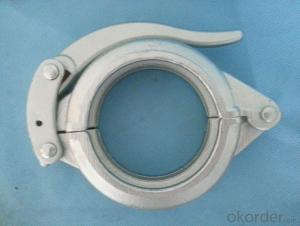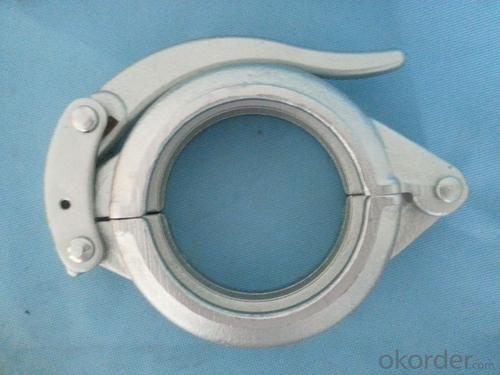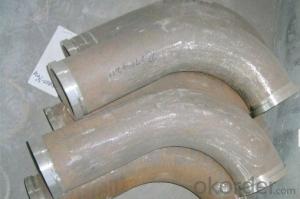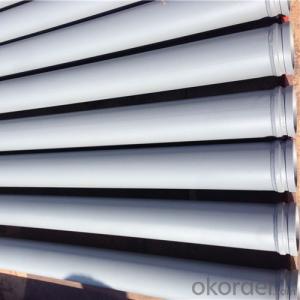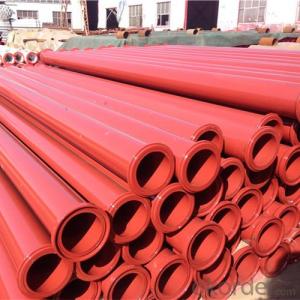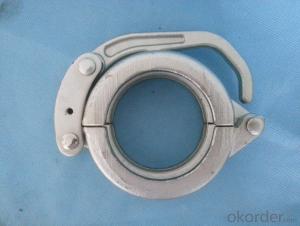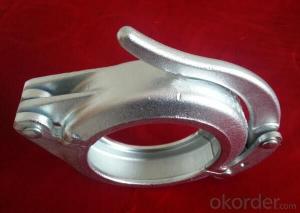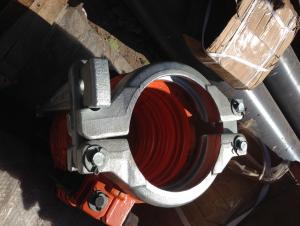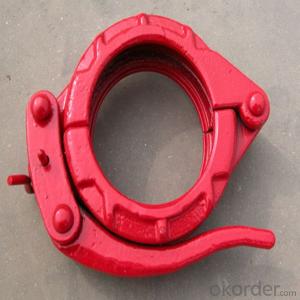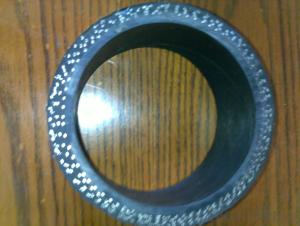Concrete Pump Clamp DN100 4
- Loading Port:
- China main port
- Payment Terms:
- TT OR LC
- Min Order Qty:
- 20 PCS
- Supply Capability:
- 1000 PCS/month
OKorder Service Pledge
OKorder Financial Service
You Might Also Like
Product Description:
A coupling is a device used to connect two delivery pieps together at their ends for the purpose of transmitting, and prevent the concrete from leaking. Couplings do not normally allow disconnection of shafts during operation.
Main Product Features:
1.Forged
2.2--8 inch
3.Galvanizing/Baking varnish
4.More durable,light,beautiful
Production steps:
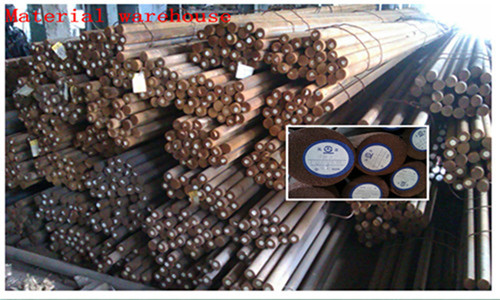

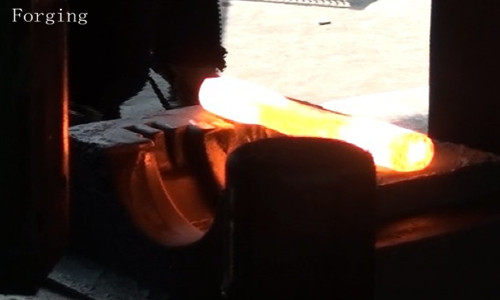
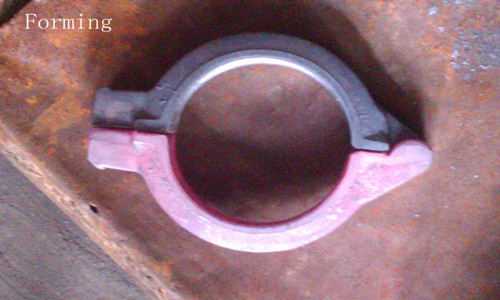

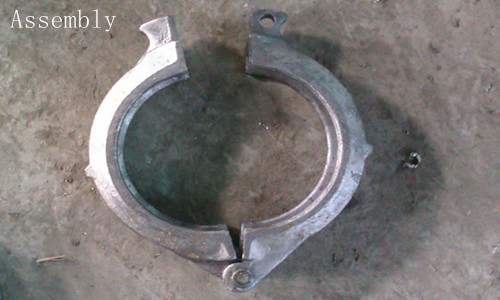
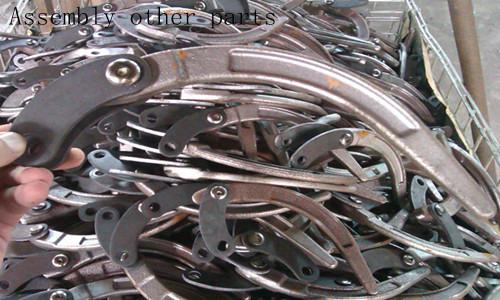
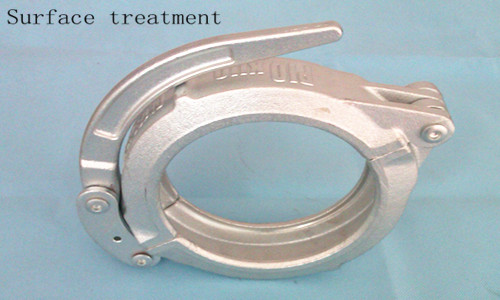
Concrete pump clamp Catalogue:
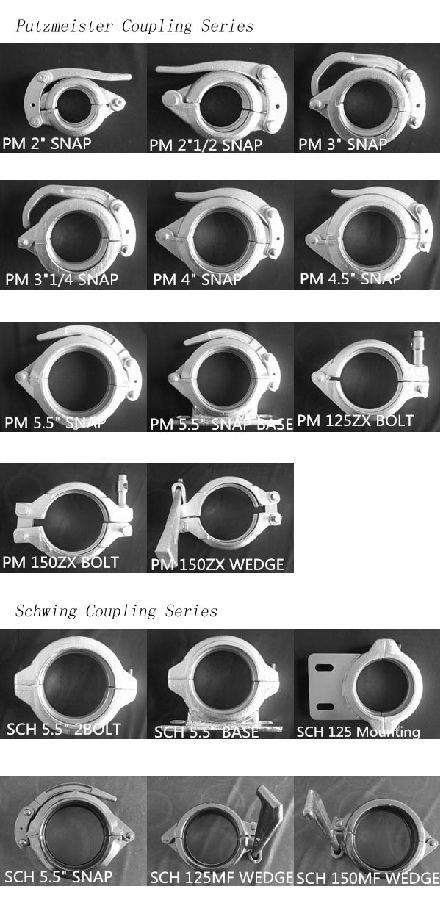
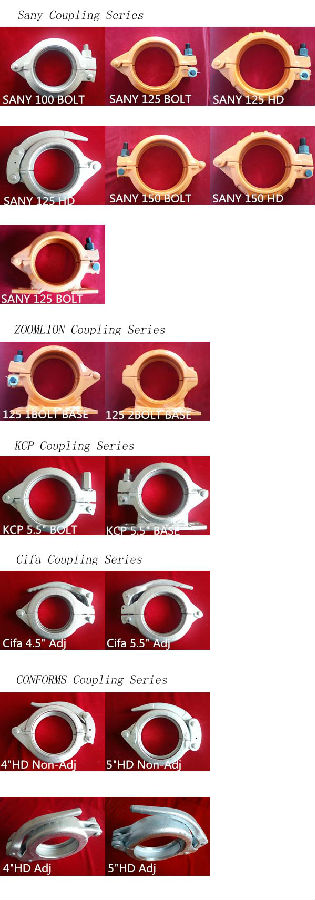
FAQ:
1.How do you regarding your product quality?
As our principle is more safety to save more. In China, there are lots of manufactures of this line, but we are the first one that use the forging technic in producing, firmly meet the PM standard.
2.Can I get some samples?
Of course you can. Small sample for free, but you pay the express. For some products are not small, like concrete pump pipe, it’s very difficult to deliver one pipe of 3000mm. If it’s possible, we’d like that you can come here to visit our factory. Welcome!
3. I want to make our logo on the products, is that ok?
Yes, it’s totally ok. OME is available from us.What you should do is send your logo, brand name, or picture to us. And let other things leave on us.
- Q: What are the signs of a damaged concrete pump S valve?
- There are several signs that indicate a damaged concrete pump S valve. 1. Leakage: One of the most common signs of a damaged S valve is leakage. If you notice any fluid or concrete leaking from the S valve, it could be an indication of a damaged or worn-out seal or gasket. 2. Reduced pumping efficiency: A damaged S valve can lead to reduced pumping efficiency. You may notice that the concrete flow is not as smooth or continuous as before, and it may take longer to pump the same amount of concrete. 3. Increased pressure: When the S valve is damaged, it can result in increased pressure within the pump system. This can cause strain on other components of the pump and lead to further damage or malfunction. 4. Unusual noises: Another sign of a damaged S valve is the presence of unusual noises during pumping operations. You may hear grinding, squeaking, or other abnormal sounds that indicate a problem with the S valve mechanism. 5. Difficulty in switching directions: The S valve is responsible for controlling the flow direction of the concrete. If you experience difficulty or resistance when switching the direction of the concrete flow, it could be a sign of a damaged S valve. 6. Inconsistent concrete flow: A damaged S valve can cause inconsistent concrete flow, resulting in uneven distribution or blockages in the delivery line. This can lead to delays and inefficiencies in the construction process. It is important to address any signs of a damaged S valve promptly to prevent further damage and ensure the safe and efficient operation of the concrete pump. Consulting a professional or the manufacturer's guidelines is recommended for proper diagnosis and repair of the S valve.
- Q: Are there any specific guidelines for the installation of hydraulic filters or strainers in concrete pump spare parts?
- Specific guidelines exist for the installation of hydraulic filters or strainers in concrete pump spare parts. These guidelines should be followed to ensure proper installation and functionality of the filter or strainer. Here are some important considerations: 1. Size and Compatibility: It is crucial to choose a hydraulic filter or strainer that is the correct size and compatible with the specific make and model of the concrete pump. Failure to do so can lead to inadequate filtration or damage to the hydraulic system. 2. Location: The filter or strainer should be installed in a location that allows for easy access and maintenance. It should be positioned in a way that facilitates proper filtration without obstructing the flow of hydraulic fluid. 3. Mounting: To prevent movement or vibration during operation, the filter or strainer must be securely mounted. It is essential to adhere to the manufacturer's instructions regarding proper mounting techniques and torque specifications. 4. Orientation: Pay attention to the recommended orientation of the filter or strainer. Some filters have specific flow direction requirements, and incorrect installation can impact their performance and efficiency. 5. Protection: Consider adding extra protection, such as a guard or shield, to shield the filter or strainer from external factors like debris or impacts. This can extend the lifespan and effectiveness of the filter. 6. Maintenance: Regularly inspecting and cleaning the filter or strainer is important to ensure optimal functioning. Adhere to the manufacturer's recommended maintenance schedule and procedures for replacement or cleaning to maintain efficient filtration. Remember to consult the manufacturer's instructions and guidelines for the specific hydraulic filter or strainer being installed, as they may have unique recommendations or requirements for their product.
- Q: Are there any specific guidelines for the installation of pipe or hose assemblies in concrete pump spare parts?
- Yes, there are specific guidelines for the installation of pipe or hose assemblies in concrete pump spare parts. These guidelines ensure proper installation techniques are followed to ensure the assemblies are securely and correctly installed. It is important to consult the manufacturer's instructions and adhere to industry standards to ensure optimal performance and safety of the concrete pump spare parts.
- Q: How often should concrete pump hydraulic motors be inspected and replaced?
- The inspection and replacement frequency of concrete pump hydraulic motors varies depending on several factors, including usage intensity, maintenance practices, and the specific guidelines of the manufacturer. However, as a general guideline, it is advisable to inspect hydraulic motors every 6 to 12 months. During this inspection, it is important to check for signs of wear and tear, leaks, and any abnormal noises that may occur during operation. Additionally, regular maintenance tasks like lubrication and cleaning should be carried out according to the manufacturer's recommendations. Ultimately, the decision to replace hydraulic motors should be based on their overall condition and performance. If noticeable issues or a significant decrease in efficiency are observed, it may be necessary to replace the hydraulic motors before the suggested inspection interval.
- Q: Can I get spare parts for concrete pumps with different types of valve systems, such as S-valve or gate valve?
- Yes, it is possible to get spare parts for concrete pumps with different types of valve systems, such as S-valve or gate valve. Concrete pump manufacturers and suppliers usually offer a wide range of spare parts for their equipment, including valves. These spare parts can be ordered directly from the manufacturer or through authorized distributors. It is important to provide specific information about the concrete pump model, valve type, and any other relevant details when ordering spare parts to ensure compatibility. Additionally, there are specialized companies that focus on supplying spare parts for concrete pumps, regardless of the valve system type. These companies often have a comprehensive inventory of spare parts and can assist in identifying and sourcing the required parts for your specific concrete pump.
- Q: How can a malfunctioning control box affect the pump's operation?
- A malfunctioning control box can have various negative effects on the operation of a pump. Firstly, it can result in an inaccurate or inconsistent control of the pump's functions. This means that the pump may not start or stop at the desired times or operate at the correct speed, leading to inefficient or inadequate pumping. Additionally, a malfunctioning control box may cause electrical issues, leading to power fluctuations or even power surges. These electrical problems can cause damage to the pump's motor or other components, leading to premature wear and tear or complete failure. Furthermore, a malfunctioning control box can also disrupt the communication between the pump and other systems. This can affect the pump's ability to receive or send signals, resulting in a lack of coordination with other equipment or systems that rely on the pump's operation. This lack of coordination can lead to system failures or disruptions in the overall process or operation that the pump supports. In summary, a malfunctioning control box can have detrimental effects on the pump's operation including inaccurate control, electrical issues, and disruption of communication with other systems. It is crucial to regularly inspect and maintain control boxes to prevent these malfunctions and ensure the reliable and efficient operation of pumps.
- Q: How can a damaged concrete pump piston affect the pumping efficiency?
- A damaged concrete pump piston can significantly affect the pumping efficiency in various ways. Firstly, a damaged piston can lead to decreased power and force exerted by the pump, resulting in reduced pumping capacity. The piston is responsible for creating the necessary pressure to push the concrete mixture through the pumping system. If it is damaged, it may not be able to generate sufficient pressure, leading to slower and less efficient pumping. Secondly, a damaged piston can cause leaks within the pump system. The piston is a critical component that seals the concrete and prevents it from leaking back into the hopper. If it is damaged or worn out, it may not create a tight seal, resulting in leakage. This not only leads to a loss of material but also reduces the efficiency of the pumping process as the pump has to work harder to compensate for the loss. Furthermore, a damaged piston can also cause blockages and clogs in the pumping system. The piston's movement creates suction, which pulls the concrete mixture into the pump. If the piston is damaged, it may not create enough suction, causing the mixture to flow unevenly or get stuck in the system. This can cause delays and interruptions in the pumping process, reducing overall efficiency. In conclusion, a damaged concrete pump piston can impact pumping efficiency by reducing power and force, causing leaks, and leading to blockages. Regular maintenance and timely repair or replacement of damaged pistons are essential to ensure optimal pumping performance and efficiency.
- Q: How can a faulty electric motor affect the pump's performance?
- A faulty electric motor can significantly impact the pump's performance. It may cause the motor to run at a slower speed, leading to reduced pumping capacity and lower flow rates. Additionally, a faulty motor can result in increased power consumption, decreased efficiency, and overheating issues. In severe cases, the motor may completely fail, causing the pump to stop working altogether. Therefore, addressing any issues with the electric motor promptly is crucial to maintaining optimal pump performance.
- Q: What is the function of a concrete pump hydraulic accumulator?
- The function of a concrete pump hydraulic accumulator is to store energy from the hydraulic system and release it when needed, providing a surge of power to the concrete pump. This helps to maintain a consistent and smooth flow of concrete, preventing any disruptions or blockages in the pumping process.
- Q: Can concrete pump spare parts be coated with corrosion inhibitors for long-term storage?
- Yes, concrete pump spare parts can be coated with corrosion inhibitors for long-term storage. Corrosion inhibitors are chemicals that can be applied to metal surfaces to prevent or minimize the corrosion process. By applying a corrosion inhibitor coating on concrete pump spare parts, it can create a protective layer that prevents moisture and oxygen from coming into contact with the metal, thus reducing the risk of corrosion. This is particularly important for long-term storage, as the spare parts may be exposed to harsh environmental conditions or stored in damp areas. The corrosion inhibitor coating can help to extend the lifespan of the spare parts and ensure they remain in good condition until they are needed for use.
Send your message to us
Concrete Pump Clamp DN100 4
- Loading Port:
- China main port
- Payment Terms:
- TT OR LC
- Min Order Qty:
- 20 PCS
- Supply Capability:
- 1000 PCS/month
OKorder Service Pledge
OKorder Financial Service
Similar products
Hot products
Hot Searches
Related keywords
